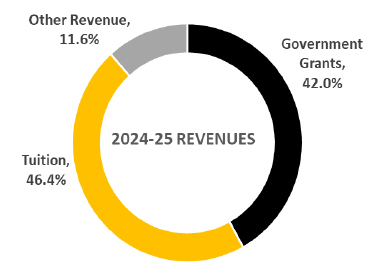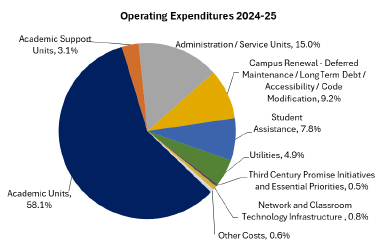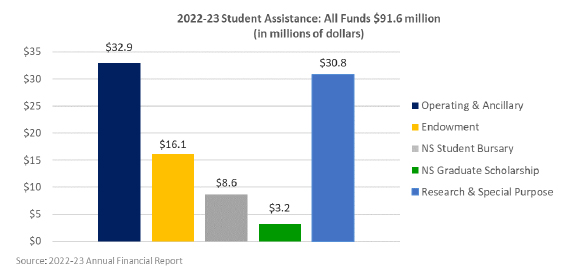Earlier this week (Tuesday, February 13), the draft Dalhousie Budget Plan for 2024-25 was shared with students, faculty and staff.
Prepared with the counsel of Dalhousie’s Budget Advisory Committee (which advises the president on the university operating budget), the budget plan includes expectations for revenues and expenses, tuition and fee recommendations, and a summary of projects being supported through Integrated Planning.
Read the full budget plan: dal.ca/budget
"The proposed budget plan offers our best strategic thinking on how to balance the operating budget in light of additional constraints, align with and protect the imperatives and values associated with our academic mission, and strategically align with provincial goals as we fulfill our commitments to the principles as a civic university," write Provost Frank Harvey and Vice-President Finance and Administration Gitta Kulczyski in their memo to the university community.
Here is a summary of what's in the draft budget plan, and how members of the university community can provide input and feedback.
Revenues: Provincial funding, enrolment expectations
Nearly 90% of Dalhousie’s operating revenue — funds used to pay for faculty and staff compensation (salaries, benefits, pension), general Faculty/unit expenses, student assistance, libraries, facilities upkeep and more — comes from just two sources: the provincial operating grant and tuition fees.

Earlier this month, the Province of Nova Scotia announced that Dalhousie’s operating grant will be frozen at the same level it was this past year. As for tuition, that is dependent on enrolment and in this current academic year enrolment fell short of budget expectations. The draft budget plan assumes enrolment will stay roughly the same in 2024-25 as it was this year, though it notes that several initiatives are underway to improve recruitment and retention for 2024-25. If enrolment does improve, additional revenues will be used to support one-time expenditures next year.
Expenses: Reducing costs
Everything costs more each year — that’s true for individuals these days, and it’s true for universities as well. Some of that is inflationary costs and some of that is compensation for faculty and staff, which increases based on with collective agreements with Dal's employee groups. Below, you can review the various areas where Dalhousie's expenses are allocated:

With limited revenue available, part of balancing the budget is reducing costs. With Dalhousie’s current budget process, there are two ways of doing this:
Reducing budget allocations for Faculties and units: After compensation increases are applied, Dalhousie asks Faculties and units to reduce expenses by a specific percentage. The budget team believed “the magnitude of the budget gap to be addressed by Faculties and units should be minimized as much as possible” to support the overall academic mission. Given the limited revenues for 2024-25, the draft budget plan asks Faculties and units to reduce costs by 1.75%.
Finding cost savings from centrally funded budget areas: There are several budget lines that are centrally funded, and it is from these areas that the budget plan identifies $20 million in savings. This includes facilities renewal and accessibility projects, though the plan notes that is sufficient funds remain to meet commitments associated with all existing accessibility projects. (A summary of these changes to expenditures can be found on page 5 of the plan.)
It remains critical for Dalhousie to still devote resources to important university priorities. Beginning on page 19 of the report, you'll find an overview of priorities for the academic and other units for 2024-25.
Tuition fees: Proposed increases
Tuition increases are also part of balancing the budget. Without tuition increases, more significant cuts to programs and services would be necessary.
For domestic students, the budget plan would increase tuition fees by 2%. This aligns with the updated tuition cap in Nova Scotia, which limits tuition increases to 2% for students from the province.
Last year, Dalhousie introduced a new tuition guarantee that applies to new students entering select programs. That means those students pay the same tuition annually in each year of their program — their tuition doesn't increase or decrease. Next year, the tuition fees for new international students entering a guaranteed tuition program will increase by 6%, while international students (current and new) not studying under a tuition guarantee will see tuition increase by an average of 7.2%.
Student assistance: Continued investment
Though there are a variety of spending cuts and cost reductions in the budget, student assistance isn’t one of them. Recognizing the need to continue to support students through financial pressures, the plan increases student assistance from the operating budget by an additional $1 million.
This increases the total direct student support distributed by Dalhousie each year to more than $92 million across all funds. This includes student employment, scholarships, bursaries, research and more.

Contributing your feedback
The budget plan is set to be presented to the university's Board of Governors for approval at its March meeting. Before then, students, faculty and staff are invited to provide their feedback. The budget team wants to hear about how Dalhousie should prioritize funding to best meet the needs of its students and help understand constraints and challenges.
If you'd like to contribute, check your dal.ca email for your survey link (sent on February 13).
A reminder that you can learn more about the budget, and review the full budget plan, at dal.ca/budget

